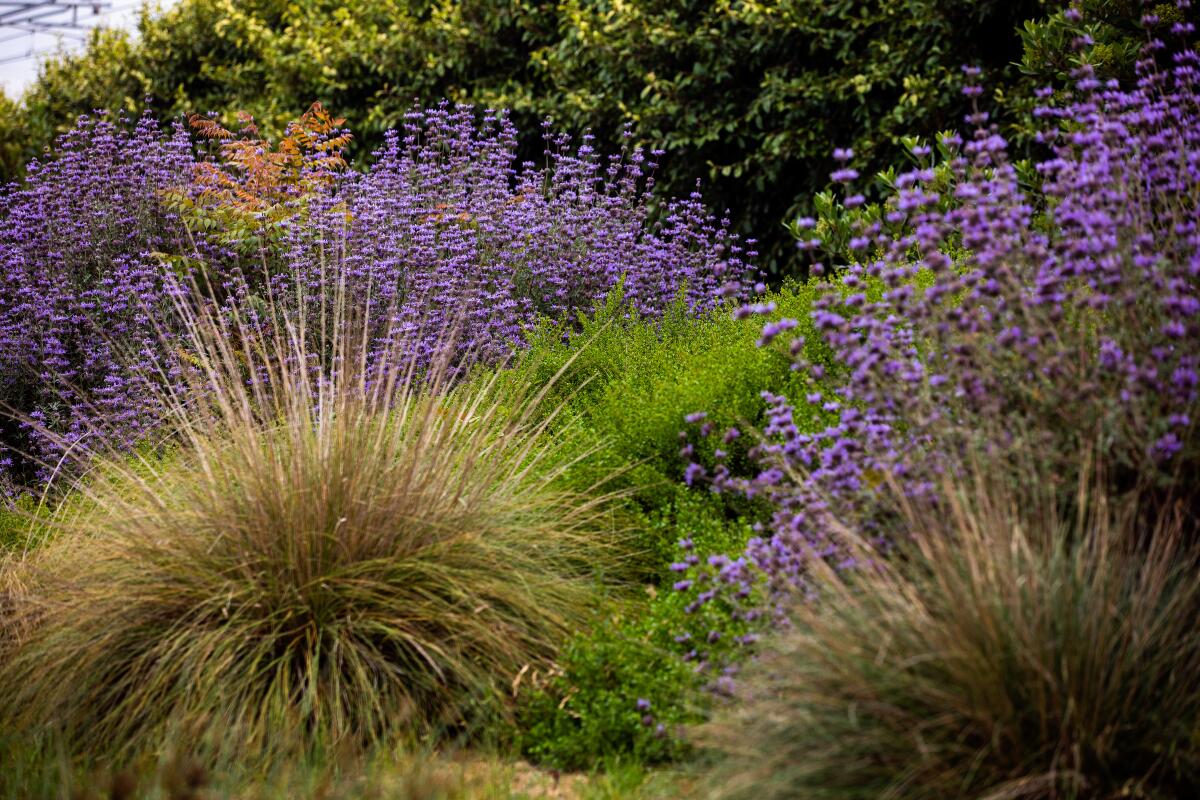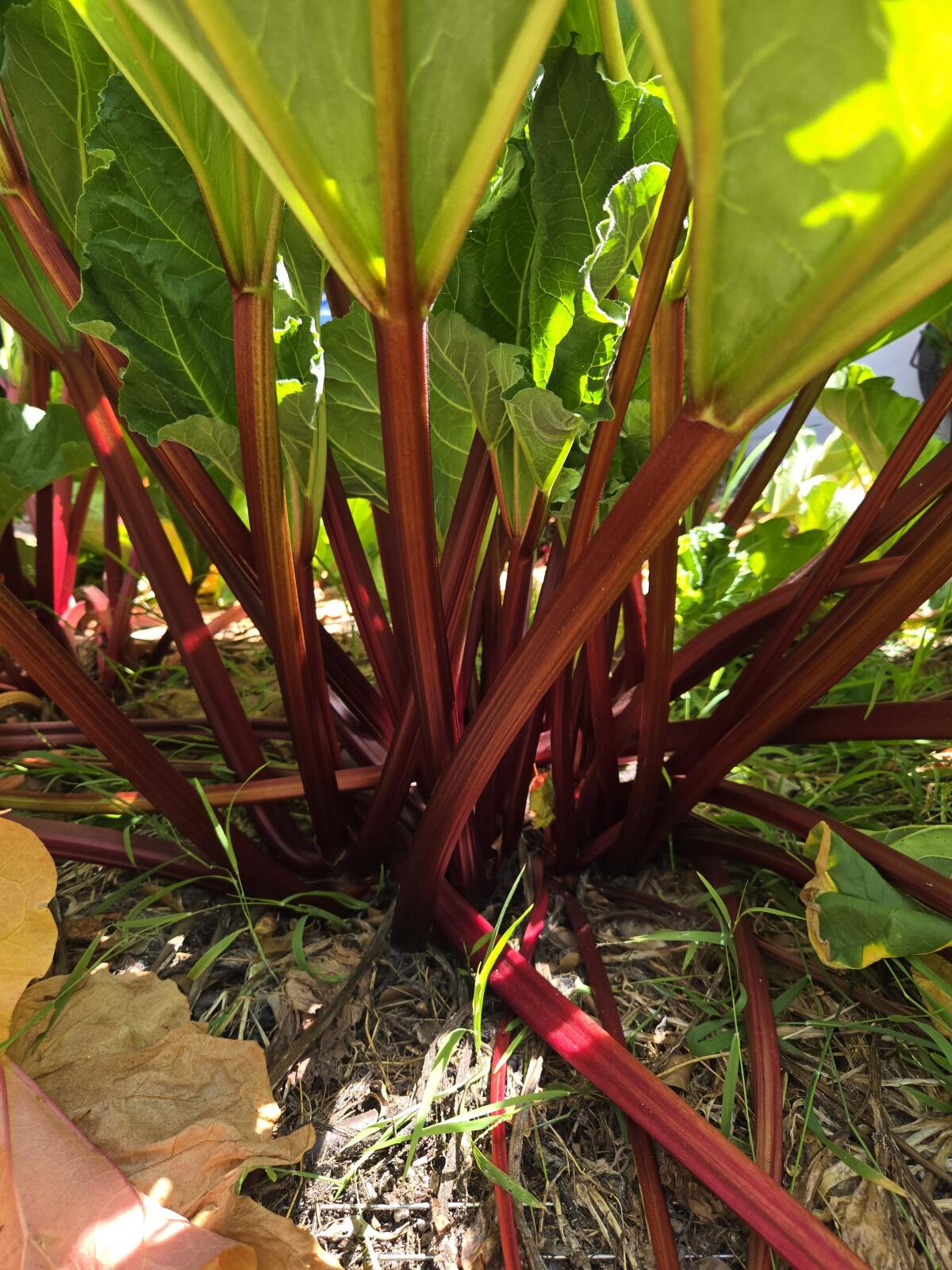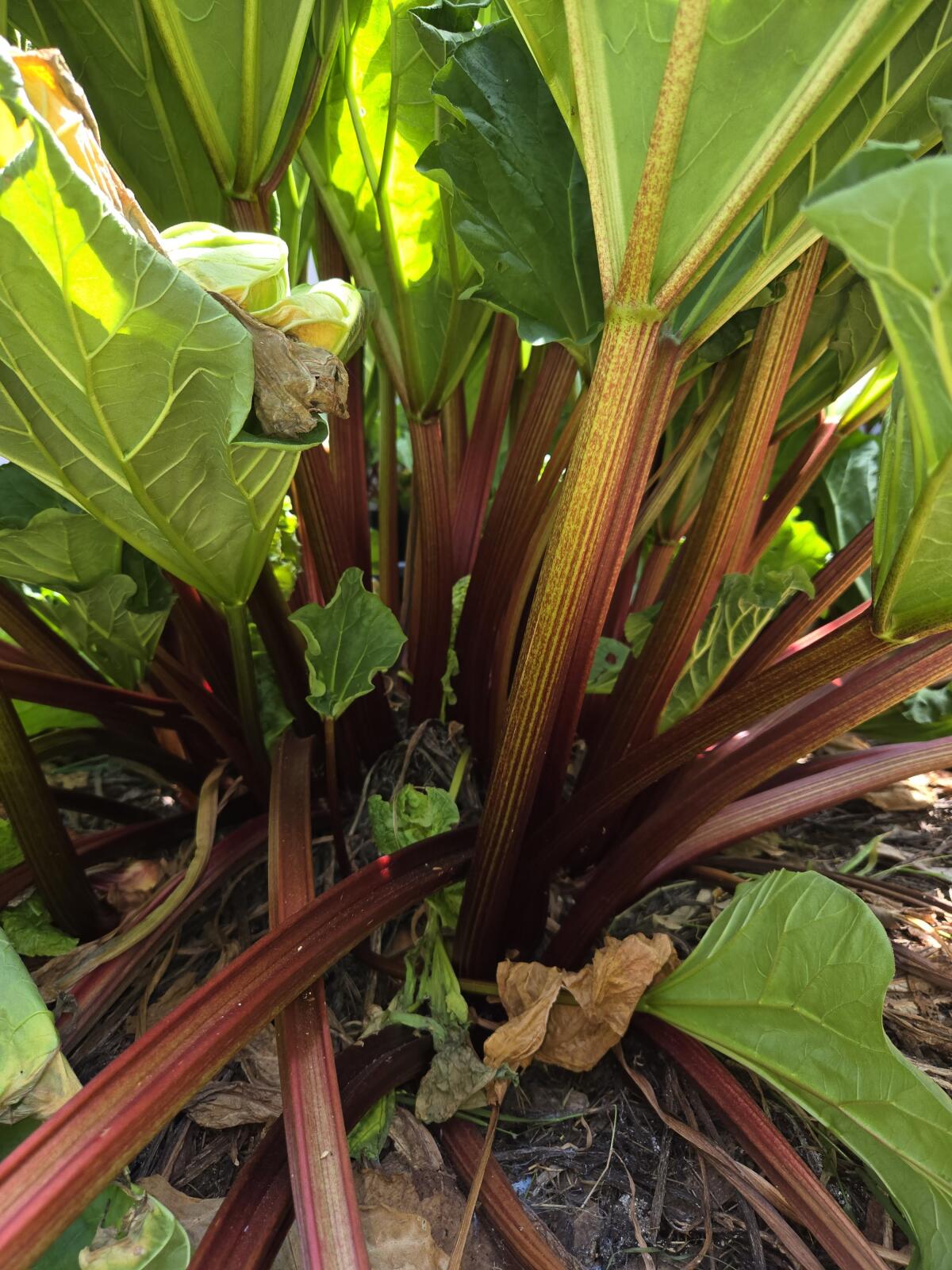How to visit Westwood Greenway’s stream and native habitat
The second anniversary of the L.A. Times Plants newsletter is upon us. It started with roughly 3,000 readers back in July 2023 and now has more than 12,000 subscribers, strong evidence that Southern Californians care deeply about plants, gardening and our region’s changing landscapes.
Many thanks for your continued interest and support!
Per usual, this issue includes a list of plant-related events and activities below, but first I’d like to revisit a story from the first Plants newsletter with the happy news that while the wheels of progress often move slowly (or sometimes even backward) progress can happen, if the players just hang on.

A crow takes a drink from the small creek that runs through the Westwood Greenway between Overland Avenue and Westwood Boulevard in Los Angeles, along the Exposition rail line.
(Mel Melcon / Los Angeles Times)
Two years ago, this newsletter’s inaugural story was about the “lovely but puzzling” Paul Koretz Westwood Greenway, an oasis of fragrant native plants and a burbling stream along a wide, curvy trail between Overland Avenue and Westwood Boulevard next to the Metro E line.
Newsletter
Sign up for our L.A. Times Plants newsletter
Get a monthly roundup of upcoming plant-related activities and events in Southern California, along with links to tips and articles you may have missed.
You may occasionally receive promotional content from the Los Angeles Times.
“The project was a triumph for the Rancho Park community members who lobbied hard against early plans to build a 170-space parking lot on the site to serve Metro riders,” I wrote in 2023. “They envisioned an inviting green space for the neighborhood and an eco-friendly showcase for turning unused nuggets of city land into lush native plant habitats for birds, pollinators and other local critters.”
That vision was realized when the project was completed in October 2020, except for one thing: The public couldn’t get in.
The greenway wasn’t meant to be a park, the builders said. It was designed to capture water running through neighborhood gutters and clean out the nasties it collects along the way, such as road dirt and dog urine, before it reaches the ocean. The cleaning is done by exposing the water to sunlight and filtering it through native plants like cattails before it returns to storm drains and, eventually, the Santa Monica Bay.
But advocates in the community support group Westwood Greenway Inc. noted that the space was also supposed to be a demonstration garden of sorts, to encourage similar projects around L.A. Members of the nonprofit group had a key to let them enter the space for volunteer weeding parties or monthly tours, but otherwise the site was kept behind glass (or, in this case, an ugly chain-link fence) much to the frustration of longtime advocate Jonathan Weiss, president of Westwood Greenway Inc., and Annette Mercer, the board’s chair.

Orange spires of apricot mallow frame the work of Alexis Wieland, a former board member for Westwood Greenway Inc. as he pulls weeds near the Metro E train line in June 2023.
(Mel Melcon / Los Angeles Times)
“The point was to educate the public,” Weiss said, “but how do we do that if it’s behind a damn fence?”
But two years later, I’m happy to report that the wheels kept moving, albeit “very, very, very slowly,” Mercer said. When Phase 2 of the project is completed this summer, the public will finally have daily access to the greenway via gates that automatically unlock at 8 a.m. and lock up again at 6 p.m.
Phase 2 was supposed to be completed on June 30 Weiss said, but a week before, he was notified that the finish date had been pushed to Aug. 1. The delay is disappointing, he said, “but this is just a hiccup. After five years, I’m extremely excited it will be open to the public. It’s finally coming, so I’m not going to sweat an extra month.”
The L.A. Sanitation project includes installing taller fences at the east and west edges of the greenway, building an ADA ramp from the Metro stop near Overland Avenue to the greenway trail, and repairing the decomposed granite (DG) path that was damaged by trucks coming into the area, said Leo Daube, communications director for Los Angeles City Councilwoman Katy Yaroslavsky, whose Council District 5 oversees the area.
And that’s not the only good news. Westwood Greenway Inc. and the Nature Nexus Institute, a nonprofit focused on nature education, got a $100,842 grant from the Measure W-funded Safe Clean Water Program in May. The grant will help pay for a Nature Nexus Institute-trained employee to develop an education program about the greenway’s purpose and history and bring in visitors for tours, Weiss said. The grant will also pay for a small trailer at the west end of the greenway so the employee has a place to work, and a porta-potty at the site (although right now it’s not certain anyone besides the employee will be able to use the toilet. The community group has asked the city council to install public modular restrooms for the visiting public).

Bright purple blooms of native Cleveland sage highlight spiky copper-colored clumps of deergrass and bright green coyote brush inside the Paul Koretz Westwood Greenway, which will be open to the public later this summer.
(Mel Melcon / Los Angeles Times)
There are still concerns, Weiss said. The greenway has two sections that run north and south of the Metro E Line and bike trail. The weeds have returned with vigor since construction began on the north side because volunteers can’t get in until the work is completed, Mercer said. And the area to the south, where stormwater runs through more native plant filters before returning to the drains, will remain fenced off to visitors even after Phase 2 is complete.
But the grant is getting them much closer to their goals. Weiss hopes the council will allow them to install signs along the bike trail to help passersby understand they’re not just looking at pretty flowers behind that chain-link fence but California native plants that can save water and create habitats for threatened pollinators and wildlife.
His disappointment about the delay suddenly vanishes as he lays out the possibilities. “What an opportunity to educate people!” he exclaimed, his enthusiasm still evident — and inspiring — despite his many years of lobbying and waiting. And that, folks, — that sometimes annoyed, sometimes frustrated but always unrelenting passion — may be the secret sauce to getting things done.
Speaking of slow-but-sweet success stories: Here’s another about rhubarb, a tangy garden staple that grows like a weed in colder climes but is rarely seen in SoCal gardens because it prefers freezing winters. Thanks to the tenacity of the West L.A Chapter of the California Rare Fruit Growers, varieties nurtured in Australia are growing with gusto around L.A. and available for you to buy for planting through the chapter’s annual Rhubarb Rodeo.

This rhubarb variety, named Success, has deep red stalks — the only edible part of the plant — and a sweeter flavor than most. Just avoid the leaves, which are high in toxic oxalic acid.
(Ronni Kern)
It all started in 2020 when chapter President Ronni Kern, a Rhode Island native now living in Santa Monica, got a hankering for the rhubarb she loved as a child. She learned the great plant breeder Luther Burbank successfully developed varieties from New Zealand to grow in Southern California in the late 1800s, but those strains disappeared after Burbank died in 1926. After a long search, she discovered tasty, heat-resistant varieties developed by Australian farmers Colin and Tina Clayton of French Harvest and bought several types of their rhubarb seeds for chapter members to grow.
The results were spectacular, she said, so successful that in 2022 the chapter began selling rhubarb plants as a fundraiser. They are offering four varieties this year — including Success (the tastiest and deepest red of all, according to Kern) and Tina’s Noble, hands down the easiest to grow, she said. Prices are $10 for plants in 5-inch pots or $20 or $25 for gallon pots, but no mail order; you must drive to Culver City or Santa Monica to pick them up.

This rhubarb variety, named Tina’s Noble, has paler stalks than Success, but it has good flavor and grows well. Just be sure to only eat the stalks since the leaves are high in toxic oxalic acid.
(Ronni Kern)
Rhubarb is a vegetable that grows in tall reddish stalks topped by big broad leaves. The plant is so rare in Southern California that people sometimes confuse it with chard, “but you must never eat rhubarb leaves,” Kern said, because they contain high levels of toxic oxalic acid. Just snap off the leaves and eat the reddish celery-shaped stalks, which add a nice, tart bite to sweet desserts or can even be roasted.
You can buy rhubarb at local farmers markets, Kern said, from people who grow the plants as annuals, but she believes their flavor and pale color are far inferior to the plants she and other chapter members are growing from the Aussie seed. A last note about growing rhubarb in SoCal: the plants don’t require lots of water — Kern just uses drip irrigation twice a week — but they do prefer cooler temps. So the hotter your area, she said, the more shade the plants will require, whether from a tree or 90% shade cloth strung up on supports.
Newsletter
You’re reading the L.A. Times Plants newsletter
Jeanette Marantos gives you a roundup of upcoming plant-related activities and events in Southern California, along with our latest plant stories.
You may occasionally receive promotional content from the Los Angeles Times.
Upcoming events
Through July 15
Applications for Conejo Valley Audubon Society Lawns to Habitat & Ashes to Habitat Grants; successful applicants will receive $250 worth of bird-friendly native plants (roughly 40 to 50 plants at wholesale prices) for their new residential landscapes. Applicants must live in Agoura Hills, unincorporated Agoura, Oak Park, Simi Valley, Moorpark, Westlake Village, Thousand Oaks, Newbury Park or Camarillo and certify they have no outdoor cats with access to the property. Ashes to Habitat applicants must also show proof that the project property was within a neighborhood affected by fires from 2018 to present, but successful applicants will also receive a higher financial grant and extended time for ordering and planting. Full details available online. wp.conejovalleyaudubon.org
Through August 6
Apply for free Xerces Society Southern California Residential Habitat Kits, for residential properties, schoolyards, community gardens and urban gardens in Los Angeles, Orange, Riverside, Santa Barbara, San Bernardino, San Diego and Ventura counties. The kits include 22 plants from 10 different species, sufficient to cover about 150 to 200 square feet, designed to support threatened insects such as monarch butterflies and native bumblebees. The kits must be picked up Dec. 9-13 in (no deliveries or special orders) and planted within the month after pickup. Recipients will be required to email photographic evidence of the kit being planted and pledge not to use pesticides. xerces.org
July 5 & 6
Introduction to Wild Buckwheats (Eriogonum) of California, a two-day class starting in a classroom at 9 a.m. until noon at the California Botanic Garden in Claremont on July 5. The next day, participants will meet at Big Bear Lake from 9 a.m. to 2 p.m. to observe the many varieties of buckwheat in the wild. Participants must provide their own transportation. Register online, $125 ($110 for members of California Botanic Garden). calbg.org
July 5, 12
South Bay Parkland Conservancy El Segundo Blue butterfly walks at 10:30 a.m or 12:30 p.m., both days near Miramar Park in Redondo Beach. The free guided walks will be led by conservancy board members Ann Dakley, Esplanade Bluff Restoration Project biologist, and Mary Simun. Registration is required. southbayparks.org
July 5
Wizarding World of Plants Family Hike Night and Adult Night Hike, 5:30-7 p.m. for the family hike night and 7:30 to 9 p.m. for the adult night hike at the Los Angeles County Arboretum in Arcadia. Learn the secrets behind wands, wishing trees and other plant folklore and myths. Tickets are $20 ($15 for members) for the family hike night and $25 ($20 members) for the adult night hike. arboretum.org
July 6, 20, Aug. 1, 10, 17
Twilight Estate Tours at the Huntington, a 90-minute docent-led walking tour of the gardens explaining how Henry E. and Arabella Huntington turned their San Marino Ranch into the famous gardens, library and museums. Tours are offered at 5 and 5:30 p.m. each day. Advance registration required. Tickets are $49 adults, $39 children 4-11. huntington.org
July 8, 15 & 22
Three-part California Native Garden Design taught by Phil Davis, principal designer of Green House landscape design, 9:30 a.m. to 1:30 p.m. each day at the Theodore Payne Foundation in Sun Valley. Learn how to evaluate your existing garden, convert existing irrigation systems and consider different design approaches for a garden of California native plants. The foundation’s online course Right Plant, Right Place ($39.19 or $28.52 for members) is a prerequisite and should be taken in tandem with the design course. Register online for the design course, $348.65 ($295.29 for members) or $412.67 for couples working on one project ($359.32 for members). eventbrite.com
July 10-11, Aug. 14-15, Sept. 25-26 and Oct. 23-24
Southern California Garden Club 27th Gardening School, a series of four ten-hour courses offered by National Garden Clubs since 1958. “Courses are designed to stimulate interest in all phases of landscape design and to develop greater appreciation, pride and knowledge about residential, public and historic gardens.” Each 10-hour course is $85 ($70 for members), or $300 ($240 for members) for all four. The classes will run from 9 a.m. to 3:30 p.m. each day at the Sepulveda Center in Encino. Register online. socalgardenclub.org
July 12
BioBlitz at California State University, Northridge, G.A.R.D.E.N. to learn about creating habitat for pollinators from 9 to 11 a.m. on the half-acre campus site managed by the Institute for Sustainability. The free event will be led by two Xerces Society endangered-species conservation biologists, monarch overwintering specialist Sara Cuadra-Vargas and pollinator habitat specialist Giovanni Di Franco who helped develop the society’s habitat kit program. The event is free but registration is required. xerces.org
Efficient Watering for Fruit Trees and Vegetable Gardens, a free workshop by the Chino Basin Water Conservation District, 9 a.m. to noon at the Waterwise Community Center in Montclair. Scott Kleinrock, the district’s conservation programs manager, will demonstrate two approaches to irrigating fruit trees and how to build and run drip irrigation systems for vegetable gardens. Registration online. cbwcd.org
Santa Rita Hills Lavender Farm’s 2nd Lavender Festival from noon to 5 p.m. in Lompoc. The event includes an artisan’s market, pony rides for children, classes in making lavender wreaths and distilling lavender oil, lavender-flavored food and drink and, of course, blooming fields of lavender. Tickets are $12 if purchased in advance or $20 at the gate. santaritahillslavender.com
Irrigation Basics for Native Plants, a walk-and-talk class led by Erik Blank, horticulture educator at the Theodore Payne Foundation from 9:30 to 11:30 a.m. at the foundation nursery in Sun Valley. Learn about a variety of irrigation methods for native gardens during the dry months. Register online, $39.19 ($28.52 members) eventbrite.com
California Native Plant Cyanotype Printing, a class photographing native plants using one of the earliest photographic printing methods taught by multimedia artist and naturalist Hannah Perez, from noon to 2 p.m. at the Theodore Payne Foundation in Sun Valley. All materials provided. Register online, $60.54 ($49.87 members). eventbrite.com
Reptiles of Theodore Payne: A walk-and-talk course with Diego Blanco, a research assistant at the Occidential College Lab of Ornithology and reptile fan, from 2:30 to 4:30 p.m. at the Theodore Payne Foundation in Sun Valley. Learn about the various lizards and snakes of Southern California’s mountains and chaparrals. Participants are encouraged to wear closed-toe shoes, long pants and sun protection, and bring binoculars for easier viewing from a distance. Register online, $39.19 ($28.52 members). eventbrite.com
Bind Your Own Nature Sketch Book, noon to 4 p.m. at California Botanic Garden in Claremont. Create a handmade sketchbook with natural papers and “nature-themed embellishments” in a class taught by mixed-media artist Christina Frausto of Rotten Apple Studio. All materials provided. Register online, $70 ($60 members). calbg.org
July 16
Propagatng California Native Plants from Seed with Ella Andersson, chief botanical technician for the Theodore Payne Foundation in Sun Valley, from 9:30 a.m. to 12:30 p.m. Each student will take home the seeds they have sown from 10 species of native seeds. All materials provided. Register online, $92.55 ($81.88 members). eventbrite.com
July 18-19
11th Plumeria Festival at the Los Angeles County Arboretum in Arcadia from 4 to 8 p.m. on July 18 and 9 a.m. to 2 p.m. on July 19. The festival includes talks by experts and more than 20 vendors selling plumeria, staghorn ferns, epiphyllums, hibiscus, succulents and other plants, as well as garden art and supplies. arboretum.org
July 19
Plant-O-Rama at the Sherman Library & Gardens, 10:30 a.m. to 4 p.m. at the gardens in Corona del Mar. The annual sale, which debuted in 1972, features plants and experts from multiple organizations including the Los Angeles International Fern Society, Newport Harbor Orchid Society, Orange County Begonia Society, Saddleback Valley Bromeliad Society, Southern California Carnivorous Plant Enthusiasts and the California Native Plant Society. Admission to the sale is free with a $5 ticket to the gardens (members and children 3 and younger enter free). thesherman.org
Planning and Caring for a Southern California Rain Garden, 8:30 to 9:30 a.m. at California Botanic Garden in Claremont. The garden’s senior horticulturist, Jennifer Chebahtah, explains the importance of creating rain gardens in urban and residential areas, along with tips for how to make them. Register online, $38 ($28 members). calbg.org
Guided Family Nature Walk at White Point Nature Preserve in San Pedro at 10:30 a.m. with naturalists from the Palos Verdes Peninsula Land Conservancy to discover the wildlife, plants and beautiful ocean views in the coastal sage scrub habitat. Meet in front of the Nature Center. The walk is free. Reservations are not required. pvplc.org
July 26
Intro to Waterwise Home Landscape Renovation and Turf Replacement Rebates, a free workshop by the Chino Basin Water Conservation District, 9 a.m. to noon at the Waterwise Community Center in Montclair. Jacob Jones, the district’s conservation and sprinkler evaluation specialist, will discuss the benefits and basics of turf-removal rebate projects and converting to a low-water landscape. Register online. cbwcd.org
Consider subscribing to the Los Angeles Times
Your support helps us deliver the news that matters most. Become a subscriber.
What we’re reading
Where have all the gardeners gone? Immigration raids are worrying Southern California’s undocumented gardeners, the workers so prevalent in suburban neighborhoods that the sound of weed whackers and leaf blowers can feel like ambient noise. “People are afraid,” one gardener said, “but they still have to work.”
The second, final and most complicated stage of the Wallis Annenberg Wildlife Crossing starts this month. The project won’t be completed before the end of 2026, but already the first non-insect wildlife has been spotted on the structure that currently leads to nowhere — a Western fence lizard that somehow climbed 75 feet up to the top.
This year’s jacaranda bloom in L.A. was short a few trees following the January wildfires, but experts say many burned trees will recover. Just give them water and time, arborists say.
Are these community gardens or playgrounds for the rich? Santa Monica officials are set to approve 200% price hikes on community garden plots, with the largest plots going for $600 a year.



